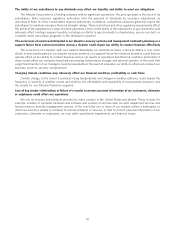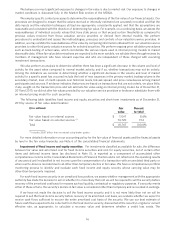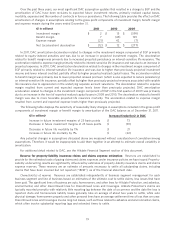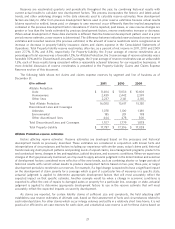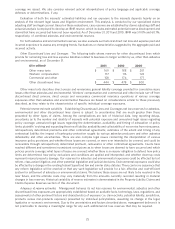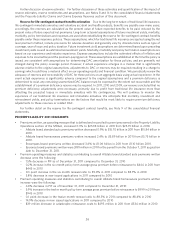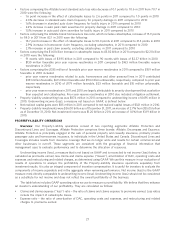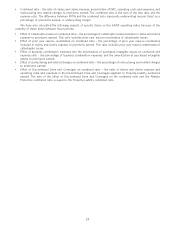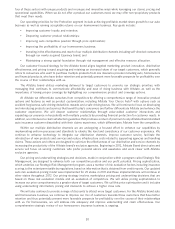Allstate 2012 Annual Report Download - page 106
Download and view the complete annual report
Please find page 106 of the 2012 Allstate annual report below. You can navigate through the pages in the report by either clicking on the pages listed below, or by using the keyword search tool below to find specific information within the annual report.Reserves are the difference between the estimated ultimate cost of losses incurred and the amount of paid losses as
of the reporting date. Reserves are estimated for both reported and unreported claims, and include estimates of all
expenses associated with processing and settling all incurred claims. We update most of our reserve estimates
quarterly and as new information becomes available or as events emerge that may affect the resolution of unsettled
claims. Changes in prior year reserve estimates (reserve reestimates), which may be material, are determined by
comparing updated estimates of ultimate losses to prior estimates, and the differences are recorded as property-liability
insurance claims and claims expense in the Consolidated Statements of Operations in the period such changes are
determined. Estimating the ultimate cost of claims and claims expenses is an inherently uncertain and complex process
involving a high degree of judgment and is subject to the evaluation of numerous variables.
The actuarial methods used to develop reserve estimates Reserve estimates are derived by using several different
actuarial estimation methods that are variations on one primary actuarial technique. The actuarial technique is known
as a ‘‘chain ladder’’ estimation process in which historical loss patterns are applied to actual paid losses and reported
losses (paid losses plus individual case reserves established by claim adjusters) for an accident year or a report year to
create an estimate of how losses are likely to develop over time. An accident year refers to classifying claims based on
the year in which the claims occurred. A report year refers to classifying claims based on the year in which the claims are
reported. Both classifications are used to prepare estimates of required reserves for payments to be made in the future.
The key assumptions affecting our reserve estimates comprise data elements including claim counts, paid losses, case
reserves, and development factors calculated with this data.
In the chain ladder estimation technique, a ratio (development factor) is calculated which compares current period
results to results in the prior period for each accident year. A three-year or two-year average development factor, based
on historical results, is usually multiplied by the current period experience to estimate the development of losses of each
accident year into the next time period. The development factors for the future time periods for each accident year are
compounded over the remaining future periods to calculate an estimate of ultimate losses for each accident year. The
implicit assumption of this technique is that an average of historical development factors is predictive of future loss
development, as the significant size of our experience data base achieves a high degree of statistical credibility in
actuarial projections of this type. The effects of inflation are implicitly considered in the reserving process, the implicit
assumption being that a multi-year average development factor includes an adequate provision. Occasionally, unusual
aberrations in loss patterns are caused by external and internal factors such as changes in claim reporting, settlement
patterns, unusually large losses, process changes, legal or regulatory changes, and other influences. In these instances,
analyses of alternate development factor selections are performed to evaluate the effect of these factors and actuarial
judgment is applied to make appropriate development factor assumptions needed to develop a best estimate of
ultimate losses.
How reserve estimates are established and updated Reserve estimates are developed at a very detailed level, and the
results of these numerous micro-level best estimates are aggregated to form a consolidated reserve estimate. For
example, over one thousand actuarial estimates of the types described above are prepared each quarter to estimate
losses for each line of insurance, major components of losses (such as coverages and perils), major states or groups of
states and for reported losses and IBNR. The actuarial methods described above are used to analyze the settlement
patterns of claims by determining the development factors for specific data elements that are necessary components of
a reserve estimation process. Development factors are calculated quarterly and periodically throughout the year for
data elements such as claim counts reported and settled, paid losses, and paid losses combined with case reserves. The
calculation of development factors from changes in these data elements also impacts claim severity trends, which is a
common industry reference used to explain changes in reserve estimates. The historical development patterns for these
data elements are used as the assumptions to calculate reserve estimates.
Often, several different estimates are prepared for each detailed component, incorporating alternative analyses of
changing claim settlement patterns and other influences on losses, from which we select our best estimate for each
component, occasionally incorporating additional analyses and actuarial judgment, as described above. These micro-
level estimates are not based on a single set of assumptions. Actuarial judgments that may be applied to these
components of certain micro-level estimates generally do not have a material impact on the consolidated level of
reserves. Moreover, this detailed micro-level process does not permit or result in a compilation of a company-wide roll
up to generate a range of needed loss reserves that would be meaningful. Based on our review of these estimates, our
best estimate of required reserves for each state/line/coverage component is recorded for each accident year, and the
required reserves for each component are summed to create the reserve balance carried on our Consolidated
Statements of Financial Position.
20


